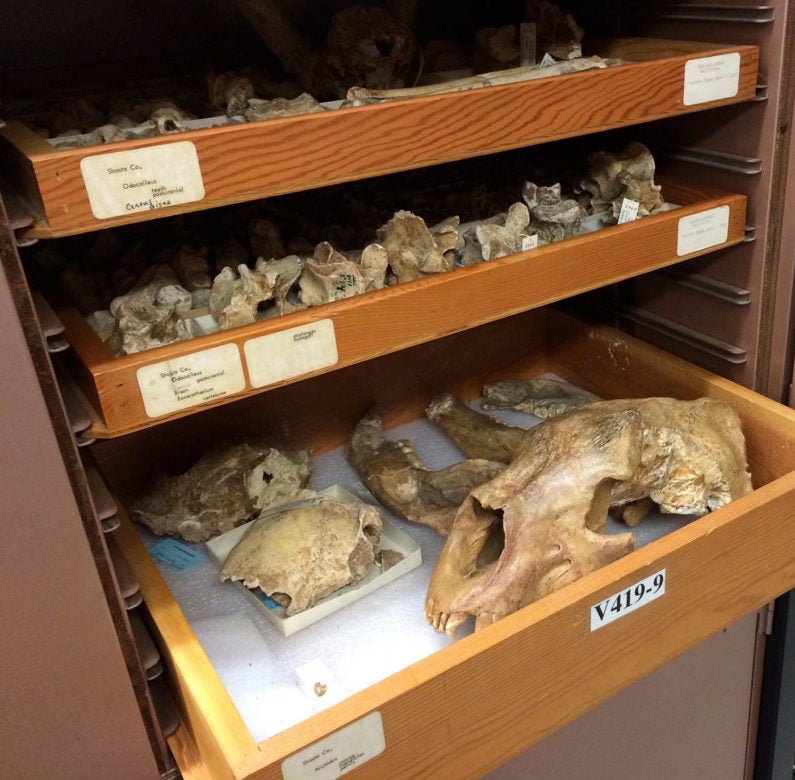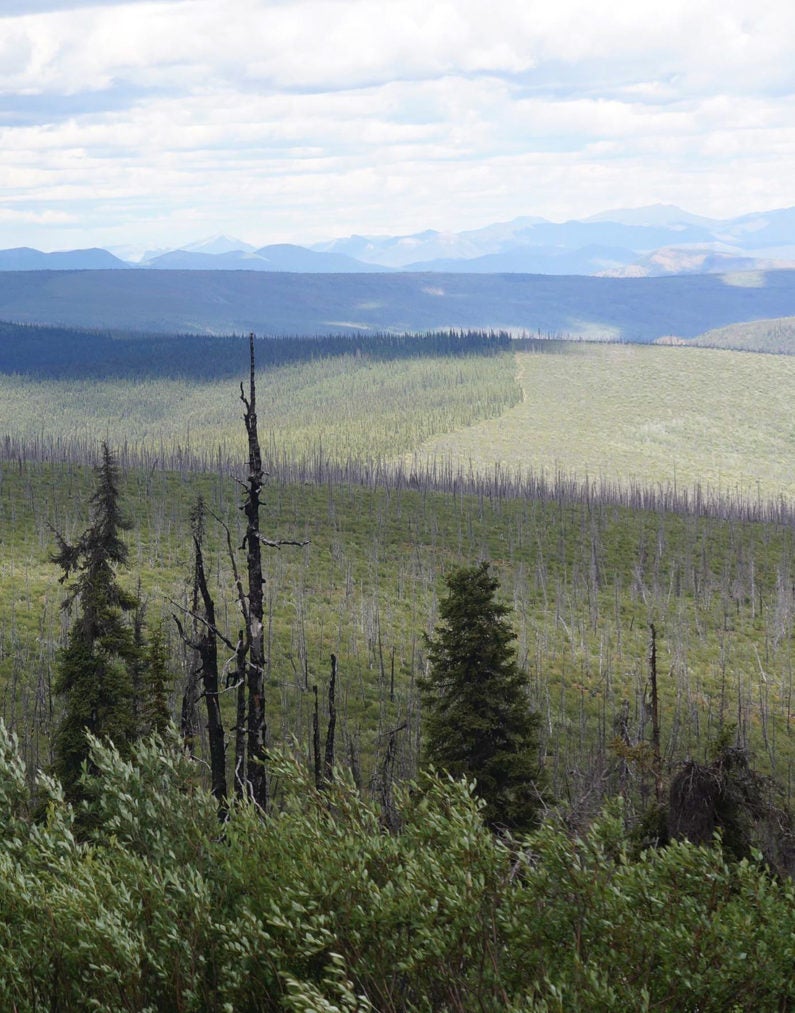Stanford researchers among those discussing the future of conservation
The world is changing too fast for nature to keep up. Conservation scholars, including those at Stanford, agree that strategies need to evolve to consider not only how ecosystems operated in past decades and centuries, but also thousands and millions of years ago.
Conservationists need to adopt a critical shift in thinking to keep the Earth’s ecosystems diverse and useful in an increasingly “unnatural” world.

Fossils such as these in the collections of the University of California Museum of Paleontology, remnants of animals that roamed California near the end of the last ice age, help guide conservation efforts going forward. (Image credit: Anthony D. Barnosky)
That was among the conclusions of conservationists from every continent but Antarctica who gathered at the University of California, Berkeley in September 2015 to discuss the future of conservation. The meeting included a diverse mix of countries and of specialists, including ecologists, conservation biologists, paleobiologists, geologists, lawyers, policymakers and writers.
Their discussions, summarized and published in Science on Feb. 9, recommend a more vigorous application of information garnered from the fossil record to forward-thinking conservation efforts. Their thinking goes like this: If conservationists reach back in history far enough, the past will suggest not only how ecosystems were once composed, but how they could best function in the future.
Those at the meeting also said that conservationists must take a wider view of nature than they may have in the past. This still means, in many cases, saving individual species or attempting to maintain some ecosystems much as they are, which is how conservation is generally perceived. But it also means accepting that not all human uses of the environment are inherently bad.
“Changed landscapes aren’t necessarily trashed landscapes,” said Anthony Barnosky, executive director of Stanford’s Jasper Ridge Biological Preserve, professor emeritus of integrative biology at UC Berkeley and senior author of the Science paper. “These landscapes can actually be used to help in nature conservation. The question is, how do you best do that?”
Integrating the fossil record
Also among the Science co-authors is Alexis Mychajliw, a Stanford biology researcher who does fieldwork in the Dominican Republic and whose work exemplifies the new recommended approach to conservation. She explores the fossil record of the island nation to see what its ecosystems were like both before European settlers and before any human habitation. The comparisons between these previous states and the present day can be striking.
“Where I work, you only see two living terrestrial mammal species,” said Mychajliw, a graduate student in the laboratory of Stanford biology professor Elizabeth Hadly, who is also a co-author of the paper. “But if you dig, actually dig in the dirt, you’ll find there were once 25 species of mammals native to this area.”

Human activities transform landscapes even in remote places, as illustrated by the dead trees and habitat fragmentation in Alaska’s Tetlin Wildlife Refuge, affected by climate change and logging. (Image credit: Elizabeth A. Hadly)
This is just one instance of how the fossil record can fill in blanks in natural history that conservationists may be unaware are even missing. Rather than rely on reports or conjecture about what the natural world was like 500 years ago, specialists can piece together what it was like during various periods stretching back millions of years.
Given that some natural cycles work on these grand timescales, going back even further than centuries helps explain how cycles may overlap and interact now and in the future. In turn, that can reveal apparent shifts in the natural world that are worthy of concern. Having access to what an ecosystem looked like at different periods in the past also suggests options for creating, achieving and maintaining conservation goals.
Recognizing novel ecosystems
Already, about 47 percent of ice-free land in the world has been transformed into what ecologists call “novel ecosystems.” These ecosystems are unique assemblages of species or systems that didn’t exist in pre-industrial times and include cropland, pastureland and timber plantations.
The Science paper (“Merging Paleobiology with Conservation Biology to Guide the Future of Terrestrial Ecosystems”) points out that these novel ecosystems are unlikely to be restored to what they were before humans. That may not be a bad thing. Instead, the authors suggest that there may be cases where conservationists should embrace novelty to understand how to move forward while supporting both natural diversity and civilization.
An example is Stanford’s Jasper Ridge Biological Preserve, says Hadly, who is the preserve’s faculty director.
“Here we have a landscape that humans have used heavily for centuries,” she said. “The species that dominate have changed through time, some of them invasives, but it still preserves a remarkable slice of California biodiversity and offers a refuge of nature in the midst of Silicon Valley. Going into the future, we expect more change, but that doesn’t lessen its conservation value.”
Whether an area is novel or historical, the paper argues that conservationists need to carefully consider the services provided by an ecosystem, including air and water purification, carbon sequestration, use of land for agriculture and tourism and the less tangible value of human interactions with the wild.
“We rely on nature for almost everything: clean water, food, materials for construction and making computers and phones,” said Allison Stegner, postdoctoral research associate at the University of Wisconsin-Madison, former graduate student at UC Berkeley and co-author of the paper. “The pace of global change today is so fast that we stand to lose all of those things that we rely on. Coming up with new approaches to conservation is essential to maintaining human life.”
The authors say keeping nature diverse, healthy and useful will likely require both historical and novel habitats, efforts that focus on saving species and efforts that don’t, input from people who use nature for different purposes and data from very long timescales, some of which can only be obtained through the fossil record.
They also said that identifying stakes and stakeholders is a task that goes beyond the sciences. With that in mind, the workshop that led to the paper opened with words from non-scientists, including a senior policy adviser to California Gov. Jerry Brown and a fiction writer who is also the mother of one of the researchers.
“They fostered a more humanist approach to our collaboration that lingers,” said Hadly.
Co-authors of this paper include Patrick Gonzalez, Jason Head, P. David Polly, A. Michelle Lawing, Jussi T. Eronen, David D. Ackerly, Ken Alex, Eric Biber, Jessica Blois, Justin Brashares, Gerardo Ceballos, Edward Davis, Gregory P. Dietl, Rodolfo Dirzo, Holly Doremus, Mikael Fortelius, Harry Greene, Jessica Hellmann, Thomas Hickler, Stephen T. Jackson, Melissa Kemp, Paul L. Koch, Claire Kremen, Emily L. Lindsey, Cindy Looy, Charles R. Marshall, Chase Mendenhall, Andreas Mulch, Carsten Nowak, Uma Ramakrishnan, Jan Schnitzler, Kashish Das Shrestha, Katherine Solari, Lynn Stegner, Nils Chr. Stenseth, Marvalee H. Wake, and Zhibin Zhang. During this research, Barnosky was in the Department of Integrative Biology and Museums of Paleontology and Vertebrate Zoology, University of California, Berkeley. Hadly is also the Paul S. and Billie Achilles Professor in Environmental Biology, senior fellow at the Stanford Woods Institute for the Environment, faculty director of Jasper Ridge Biological Preserve and a member of Stanford Bio-X. Stegner received her B.S. in Ecology and Evolutionary Biology from Stanford in 2010.
This workshop was funded by the Integrative Climate Change Biology Group, International Union of Biological Sciences; the Museum of Paleontology, Berkeley Initiative for Global Change Biology, and Office of the Vice Chancellor for Research at the University of California, Berkeley; the Conservation Paleobiology Group at the Department of Biology, Stanford University; and the Senckenberg Biodiversity and Climate Research Centre, Frankfurt, Germany. Additional funding for this work came from the National Science Foundation.
